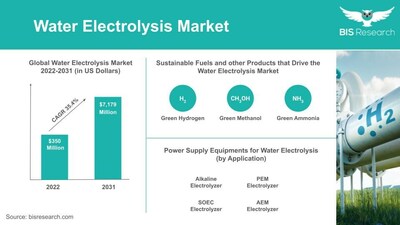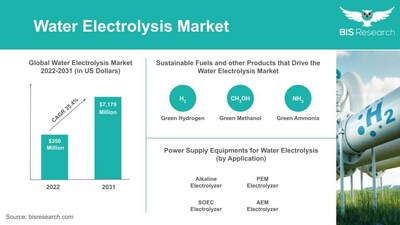FREMONT, Calif., Nov. 21, 2023 /PRNewswire/ — In August 2023, researchers at POSTECH improved water electrolysis catalysts for green hydrogen, blending iridium, ruthenium, and osmium, enhancing performance but highlighting challenges in maintaining stability. The growing demand to develop sustainable and efficient resources has pushed for various innovations.
Green Hydrogen and green Methanol are popular alternate fuels that have high efficiency. Green hydrogen can generate electricity with a high efficiency of up to 60%. This means that for every 100 kilowatt-hours of hydrogen used, up to 60 kilowatt-hours of electricity can be produced.
Water electrolysis is a sustainable method for producing Green Hydrogen. It involves using electricity to split water molecules (H2O) into hydrogen (H2) and oxygen (O2). This process is conducted in an electrolyzer, which utilizes electrodes and an electrolyte to facilitate the electrochemical reaction. Water electrolysis has proved to be one of the most viable technologies to process alternate sustainable fuels.
Why is Water Electrolysis Important?
Water electrolysis is a critical technology for producing sustainable hydrogen fuel, offering many vital advantages that align with the global shift towards a cleaner energy future.
Unlike traditional hydrogen production methods that rely on fossil fuels, water electrolysis produces hydrogen without emitting greenhouse gases. The hydrogen thus produced is called Green Hydrogen. This reduces greenhouse gas emissions by 50-70% compared to conventional hydrogen production methods.
Water electrolysis can seamlessly integrate with renewable energy sources like solar and wind power, effectively harnessing their intermittent nature. Excess energy generated during peak production can be utilized to produce hydrogen for later use, with an estimated efficiency of up to 70%.
Technological advancements in electrolyzer design are improving efficiency and reducing costs. For instance, alkaline electrolyzers exhibit an efficiency of up to 70%, while proton exchange membrane (PEM) electrolyzers can achieve up to 80% efficiency. Simultaneously, the cost of electrolyzers is projected to decline by 50% by 2030.
Key Products and Products Linked with Water Electrolysis
Water electrolysis is a crucial technology for producing hydrogen fuel, a versatile energy carrier for various applications. Water electrolysis has been critical in manufacturing hydrogen, which can be used as fuel or to manufacture fertilizers and other chemicals.
Green hydrogen:
Green hydrogen is produced using the electrolysis of water. Green hydrogen boasts a superior energy density over conventional fuels and exhibits minimal leakage compared to batteries, making it a robust energy storage medium. The petroleum refining sector’s demand for green hydrogen is soaring due to its critical role in refining processes and significant influence on the oil and gas industry. It is a clean and sustainable fuel used in various applications, including power generation, Hydrogen-powered fuel cell vehicles (FCVs) transportation, and industrial processes such as ammonia production and steelmaking.
Green hydrogen can also be produced using Ammonia crackers. It is a well-established and cost-effective method. While Ammonia cracking is scalable, water electrolysis is a carbon-free method with a higher yield purity.
Methanol:
Green methanol is a liquid fuel produced from hydrogen and carbon dioxide. It is a versatile fuel used in transportation, power generation, and industrial processes.
Ammonia:
Green Ammonia is a nitrogen-based fuel that can be produced from hydrogen and nitrogen. It is a clean and efficient fuel for transportation, power generation, and agriculture.
In addition to these specific fuels, water electrolysis is also used to produce other hydrogen-based fuels, such as methane and formic acid. These fuels can be used in various applications, including fuel cells, transportation, and industrial processes.
Future of Water Electrolysis
The future of water electrolysis is directly linked to the demand for green hydrogen. The push for water electrolysis as a preferred method to produce hydrogen is propelled by several key factors: the growing application of hydrogen in petroleum refining, an upsurge in the need for eco-friendly fertilizers, intensified governmental efforts to establish low-carbon infrastructure, and a reduction in the costs associated with renewable energy and water electrolysis technologies. According to BIS Research, the water electrolysis market is projected to reach $7.17 Billion by 2031 from $0.35 Billion in 2021, growing at a CAGR of 35.4% during the forecast period 2022-2031.
Furthermore, government policies and advisories by independent agencies are mandating steps towards carbon neutrality. Many developed economies believe producing green hydrogen with a shorter production time is necessary to reach zero carbon emissions by 2050. Many nations, including Australia, China, Germany, the EU, Japan, India, and South Korea, are interested in green hydrogen.
They are, therefore, announcing green hydrogen initiatives, several of which contain production objectives for green hydrogen. The International Renewable Energy Agency claims that by 2050, hydrogen could account for up to 12% of global energy consumption due to the urgency of addressing climate change and the nation’s goal of a net-zero emission economy.
As the cost of renewable energy continues to decline and demand for sustainable fuels increases, the adoption of water electrolysis can be expected to be more widespread in the coming years.
About BIS Research:
BIS Research is a global B2B market intelligence and advisory firm focusing on deep technology and related emerging trends, which can disrupt the market dynamics soon. We publish over 200 market intelligence studies annually, focusing on several deep technology verticals.
Our strategic market analysis emphasizes market estimations, technology analysis, emerging high-growth applications, deeply segmented granular country-level market data, and other important market parameters useful in the strategic decision-making for senior management.
BIS Research offers syndicate as well as custom studies and expert consultations to firms, providing them with specific and actionable insights on novel technology markets, business models, and competitive landscapes.
Contact:
Head of Marketing
Email: media@bisresearch.com
BIS Research Inc.
39111 PASEO PADRE PKWY STE 313,
FREMONT, CA 94538-1686
Visit our Blog @https://bisresearch.com/insights
Get Expert Insights @ https://community.insightmonk.com
Connect with us on LinkedIn @ https://www.linkedin.com/company/bis-research
Connect with us on Twitter@ https://twitter.com/BISResearch
Photo: https://mma.prnewswire.com/media/2276362/Water_Electrolysis_Market.jpg
Logo: https://mma.prnewswire.com/media/2282886/BIS_Research_Logo.jpg
![]() View original content to download multimedia:https://www.prnewswire.com/news-releases/green-hydrogen-and-related-sustainable-fuels-expected-to-drive-water-electrolysis-market-to–grow-by-cagr-of-35-4-by-2031-bis-research-301994971.html
View original content to download multimedia:https://www.prnewswire.com/news-releases/green-hydrogen-and-related-sustainable-fuels-expected-to-drive-water-electrolysis-market-to–grow-by-cagr-of-35-4-by-2031-bis-research-301994971.html
SOURCE BIS Research



